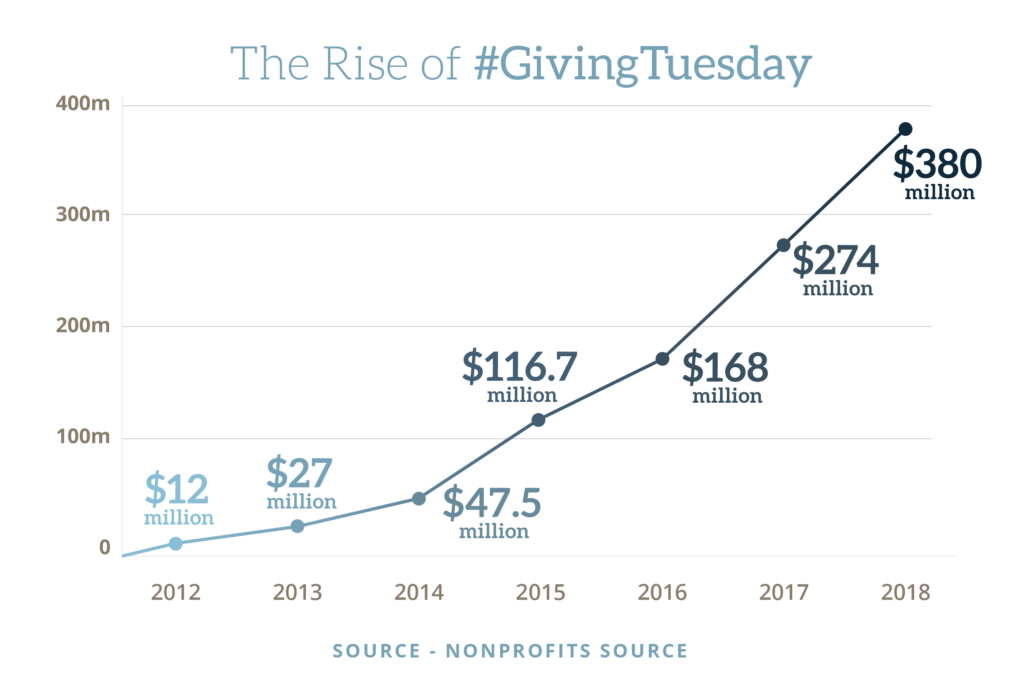Today marks GivingTuesday, a “global generosity movement” that started in 2012, and has been gaining traction ever since. After feasting through Thanksgiving and kicking off holiday shopping over Black Friday and Cyber Monday, it is a day for people to reflect on how they can give back to their community or the world.
Each year, the amount of giving has grown exponentially, along with the number of donations. In 2018, over $400 million dollars were raised online from 3.6 million gifts. It goes to show how individual acts of generosity can spark other acts of generosity, then snowball into a movement.

One of the benefits of GivingTuesday is how visible it is, which allows people to talk freely about giving.
Donating to nonprofits seems to be a sensitive topic for many people, since it crosses the societal taboo of talking about financial topics or coming across as bragging about their own altruism.
It’s easier to bring up conversations around a topic when there is a day or month to rally around, like World Mental Health Day or Black History Month. People can post and share about it on social media, strike casual conversations about giving, and rally others toward their cause of choice. Plus, the focused awareness allows people who work in the nonprofit space to tap into the collective consciousness and get their most important messages across.
While it’s a great conversation starter, we want to explore how to make the conversations continue throughout the year. One day is just not enough to discuss everything there is to know about the problems that the nonprofits are trying to solve. Having more individuals caring and participating in conversations around giving and the nonprofit space can help move solutions forward.

More individual support can free nonprofits to focus on their missions.
Nonprofits spent 10% of online revenue on digital ads in 2019. Many nonprofits have sizable budgets for marketing and fundraising. Smaller, local nonprofits may have difficulty competing against the marketing budgets of larger, multinational corporations. When individuals share where they give and why, it unlocks more grassroots support and frees up nonprofits to focus on the causes they serve rather than spending resources on marketing.
GivingTuesday is powerful in its ability to raise a significant amount of money from many individuals. For example, Team Telomere, a small nonprofit supporting families affected by Dyskeratosis Congenita and Telomere Biology Disorders, raised its entire operating budget for a year in one day. If we were able to capture the power of grassroots year-round without additional marketing effort from the nonprofits, we could start to change how fundraising happens. Instead of focusing on grand events or days, it could be one of the ways that people express their values throughout the year.
The nonprofits we spoke to valued small, individual donations for the freedom they bring. Bigger gifts often come with many restrictions or caveats, and come with the greater risk that the gift will not be recurring. It’s the same as diversifying an investment portfolio — most nonprofits would prefer $1 from 100,000 individuals than $100,000 from a single individual. Even if a few individuals stopped giving, they can still operate off the support of the others.
Consistent support allows nonprofits to plan better.
Even better would be monthly support to help nonprofits focus on their mission, not fundraising. Currently, 30% of all annual giving occurs in December, but nonprofits prefer recurring support for a few reasons: it helps them to operate smoothly throughout the year, plan better and explore longer term solutions, and not have to solicit repeatedly.
GivingTuesday provides a great foundation in starting conversations around giving and showcasing the power of grassroots support. It’s important to consider how we can continue to make giving a part of our values and strive for better solutions in the nonprofit space. To do that, we have to continue the conversations throughout the rest of the year.
That being said, today is still a day to fully embrace the giving spirit.
There are many ways to give, including your time, voice, and goods such as clothes and books. You can donate your blood, sign up to be a bone marrow donor for those with life-threatening blood cancers, or save a life in the future as an organ donor. Everyone can give in some way, and fostering more generosity in the world can heal its wounds.

